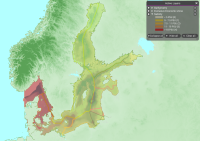(Created page with "Category:Environmental conditions =General Information= {{Infobox | title = {{PAGENAME}} | image = 200px | headerstyle = background:#595958; color:#f9f9f9; | header1 = Layer Info | label2 = Category | data2 = Management | label3 = Sub-category | data3 = Environmental conditions | label4 = Editable | No | }} ==Description== ==MSP Challenge== Here you can add information about how the layer is implemented or use...") |
No edit summary |
||
| Line 14: | Line 14: | ||
==Description== | ==Description== | ||
On average, seawater in the world's oceans has a salinity of about 3.5% (35 g/l, 35 ppt, 600 mM). This means that every kilogram (roughly one liter by volume) of seawater has approximately 35 grams (1.2 oz) of dissolved salts (predominantly sodium (Na+) and chloride (Cl−) ions) (wikipedia, 2022). | |||
Salinity influences the water's freezing point which decreases as salt concentration increases. The density of water also varies according to it's salinity. So this parameters influences stratification and species distribution. | |||
==MSP Challenge== | ==MSP Challenge== | ||
In the MSP Challenge, the salinity data layer is static and does not influence any of the models. | |||
=North Sea= | =North Sea= | ||
Not applicable. | |||
This layer is not available in the North Sea Edition. | |||
=Baltic Sea= | =Baltic Sea= | ||
| Line 62: | Line 42: | ||
Modelled bottom salinity (BALANCE) | Modelled bottom salinity (BALANCE) | ||
===Description=== | ===Description=== | ||
| Line 69: | Line 47: | ||
Information retrieved from HELCOM's metadata page for this resource (2021-07-20). | Information retrieved from HELCOM's metadata page for this resource (2021-07-20). | ||
===Creation Date=== | ===Creation Date=== | ||
Not available. Publication date: 2008-01-01 | Not available. Publication date: 2008-01-01 | ||
===Methodology=== | ===Methodology=== | ||
| Line 81: | Line 55: | ||
=Clyde Marine Region= | =Clyde Marine Region= | ||
Not applicable. | |||
This layer is not available in the Clyde Marine Region Edition. | |||
=Adriatic Sea= | =Adriatic Sea= | ||
Not applicable. | |||
This layer is not available in the Adriatic Sea Edition. | |||
Revision as of 13:29, 8 February 2022
General Information
 | |
| Layer Info | |
|---|---|
| Category | Management |
| Sub-category | Environmental conditions |
Description
On average, seawater in the world's oceans has a salinity of about 3.5% (35 g/l, 35 ppt, 600 mM). This means that every kilogram (roughly one liter by volume) of seawater has approximately 35 grams (1.2 oz) of dissolved salts (predominantly sodium (Na+) and chloride (Cl−) ions) (wikipedia, 2022).
Salinity influences the water's freezing point which decreases as salt concentration increases. The density of water also varies according to it's salinity. So this parameters influences stratification and species distribution.
MSP Challenge
In the MSP Challenge, the salinity data layer is static and does not influence any of the models.
North Sea
Not applicable.
This layer is not available in the North Sea Edition.
Baltic Sea
Types
- < 5 PSU
- 5 - 7.5 PSU
- 7.5 - 11 PSU
- 11 - 18 PSU
- > 18 PSU
Metadata
Data Source
BALANCE project, retrieved from HELCOM, acessed on 2018-06-11
Original Title
Modelled bottom salinity (BALANCE)
Description
"This dataset was produced by NERI, Denmark, for the BSR INTERREG IIIB project BALANCE. Due to the stratification in the Baltic Sea it was decided to use bottom salinity for the development of the benthic marine landscapes and difference in surface to bottom salinity for the pelagic landscapes. The following 6 categories of annual mean salinity were applied delineating the Kattegat and the Baltic Sea into regions with differences in salinity regime (fig. 15): I. Oligohaline I (< 5psu). II. Oligohaline II (5 - 7.5psu). III. Mesohaline I (7.5 - 11psu). IV. Mesohaline II (11 - 18psu). V. Polyhaline (18 - 30psu). VI. Euhaline (>30psu)."
Information retrieved from HELCOM's metadata page for this resource (2021-07-20).
Creation Date
Not available. Publication date: 2008-01-01
Methodology
Integrated directly in the platform.
Clyde Marine Region
Not applicable.
This layer is not available in the Clyde Marine Region Edition.
Adriatic Sea
Not applicable.
This layer is not available in the Adriatic Sea Edition.
 Co-funded by the European Union.
Co-funded by the European Union.